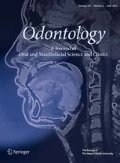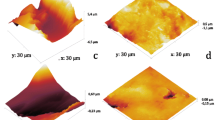Abstract
Implants with rough surfaces are today widely used. It has been speculated that rough surfaces (Ra > 0.2 μm) provide a better “substrate” for retention and accumulation of plaque in terms of area, thickness and colony-forming unit that can eventually lead to peri mucositis and/or peri-implantitis. The aim of this investigation was to evaluate in vivo the plaque accumulation after 48 h on three implant surfaces with different treatments. For this investigation, we used 21 sterilized titanium disks, with a diameter of 8mm and a thickness of 3 mm, provided by the manufacturer: 7 with machined surface, as smooth control, 7 with HA grit sandblasted RBM surface and 7 with Ca++ incorporated in titanium Xpeed surface. One disk for each surface treatment was characterized at time 0 by SEM and AFM to study, respectively, the surface morphology and roughness. The other 18 disks were mounted randomly on three upper acrylic bites in a buccal lateral position, worn for 48 h by three volunteer students for plaque accumulation. After 48 h each disk was removed and analyzed qualitatively and quantitatively by an independent operator, not involved into the study, in order to avoid bias. Data collected were statistically analyzed by one-way ANOVA. The qualitative analysis showed no differences in terms of total plaque accumulation between the surfaces. Data from quantitative analysis using Anova Test showed no significance between all groups. In this in vivo investigation all the surfaces studied promoted plaque formation. The degree of surface roughness seems not to be a critical factor for plaque accumulation.











Similar content being viewed by others
References
Albrektsson T, Donos N, Working Group 1. Implant survival and complications. The Third EAO consensus conference 2012. Clin Oral Implants Res. 2012;23:63–5.
Lindhe J, Meyle J, Group D of European Workshop on Periodontology. Peri-implant diseases: Consensus Report of the Sixth European Workshop on Periodontology. J Clin Periodontol. 2008;35(8 Suppl):282–5.
Salvi GE, Cosgarea R, Sculean A. Prevalence and mechanisms of peri-implant diseases. J Dent Res. 2017;1:31–37.
Sarmiento H, Norton M, Fiorellini J. A classification system for peri-implant diseases and conditions. Int J Periodontics Restorative Dent. 2016;9:699–705.
Newman MG, Takei H, Klokkevold PR, Carranza FA. Carranza’s clinical periodontology. 12th ed. Canada: Elsevier; 2015.
Marsh PD, Martin MV. Oral microbiology. 5th ed. London, Amsterdam: Churchill Livingstone, Elsevier; 2009.
Socransky SS, Haffajee AD, Cugini MA, Smith C, Kent RL Jr. Microbial complexes in sub gingival plaque. J Clin Periodontol. 1998;25(2):134–44.
Glossary of periodontal terms, 4th Ed. American Academy of Periodontology. 2001; p 41.
Subramani K, Jung RE, Molenberg A, Hämmerle CH. Biofilm on dental implants: a review of the literature. Int J Oral Maxillofac Implants. 2009;24:616–26.
Albouy J-P, Abrahamsson I, Berglundh T. Spontaneous progression of experimental peri-implantitis at implants with different surface characteristics: an experimental study in dogs. J Clin Periodontol. 2012;39:182–7.
Veerachamy S, Yarlagadda T, Manivasagam G, Yarlagadda PK. Bacterial adherence and biofilm formation on medical implants: a review. Proc Inst Mech Eng. 2014;228:1083–99.
Albrektsson T, Wennerberg A. Oral implant surfaces: part 1, review focusing on topographic and chemical properties of different surfaces and in vivo response to them. Int J Prosthodont. 2004;17:536–54313.
Rasmusson L, Kahnberg K-E, Tan A. Effects of implant design and surface on bone regeneration and implant stability: an experimental study in the dog mandible. Clin Implant Dent Relat Res. 2001;1:2–8.
Feller L, Jadwat Y, Khammissa RAG, Meyerov R, Schechter I, Lemmer J. Cellular responses evoked by different surface characteristics of intraosseous titanium implants. BioMed Res Int. 2015;. doi:10.1155/2015/171945.
Esposito M, Coulthard P, Thomsen P, Worthington H. Interventions for replacing missing teeth different types of dental implants. In: The Cochrane Collaboration, editor. Cochrane Database of Systematic Reviews [Internet]. Chichester:Wiley. 2005.
Wennerberg A, Albrektsson T. Effects of titanium surface topography on bone integration: a systematic review. Clin Oral Implants Res. 2009;20:172–84.
Botticelli D, Lang NP. Dynamics of osseointegration in various human and animal models—a comparative analysis. Clin Oral Implants Res. 2016;. doi:10.1111/clr.12872.
Conserva E, Lanuti A, Menini M. Cell behaviour related to implant surfaces with different microstructure and chemical composition: an in vitro analysis. Int J Oral Maxillofac Implants. 2010;25:1099–107.
Conserva E, Menini M, Ravera G, Pera P. The role of surface implant treatments on the biological behavior of SaOS-2 osteoblast-like cells. An in vitro comparative study. Clin Oral Implants Res. 2013;24:880–9.
Barbour ME, O’Sullivan DJ, Jenkinson HF, Jagger DC. The effects of polishing methods on surface morphology, roughness and bacterial colonisation of titanium abutments. J Mater Sci Mater Med. 2007;18:1439–47.
Quirynen M, Abarca M, Van Assche N, Nevins M, van Steenberghe D. Impact of supportive periodontal therapy and implant surface roughness on implant outcome in patients with a history of periodontitis. J Clin Periodontol. 2007;34:805–15.
Song F, Koo H, Ren D. Effects of material properties on bacterial adhesion and biofilm formation. J Dent Res. 2015;94:1027–34.
Teughels W, Van Assche N, Sliepen I, Quirynen M. Effect of material characteristics and/or surface topography on biofilm development. Clin Oral Implants Res. 2006;17:68–81.
Ferreira Ribeiro C, Cogo-Muller K, Franco GC, Silva-Concilio LR, Camopos MS, de Mello Rode S, Neves AC. Initial oral biofilm formation on titanium implants with different surfaces treatments: an in vivo study. Arch Oral Biol. 2016;69:33–9.
Fröjd V, Chávez de Paz L, Andersson M, Wennerberg A, Davies JR, Svensäter G. In situ analysis of multispecies biofilm formation on customized titanium surfaces: biofilms on titanium surfaces. Mol Oral Microbiol. 2011;26:241–52.
Siegrist BE, Brecx MC, Gusberti FA, Joss A, Lang NP. In vivo early human dental plaque formation on different supporting substances. A scanning electron microscopic and bacteriological study. Clin Oral Implants Res. 1991;1:38–46.
Burgers R, Gerlach T, Hahnel S, Schwarz F, Handel G, Gosau M. In vivo and in vitro biofilm formation on two different titanium implant surfaces. Clin Oral Implants Res. 2010;21:156–64.
Roehling S, Astasov-Frauenhoffer M, Hauser-Gerspach I, Braissant O, Woelfer H, Waltimo T, Kniha H, Gahlert M. In vitro biofilm formation on Titanium and Zirconia implant surfaces. J Periodontol. 2017;88:298–307.
Wennerberg A, Sennerby L, Kultje C, Lekholm U. Some soft tissue characteristics at implant abutments with different surface topography. J Clin Periodontol. 2003;30:88–94.
Renvert S, Polyzois I. Risk indicators for peri-implant mucositis: a systematic literature review. J Clin Periodontol. 2015;42:172–86.
Renvert S, Lindahl C, Rutger-Persson G. The incidence of peri-implantitis for two different implant systems over a period of thirteen years. J Clin Periodontol. 2012;39:1191–7.
Acknowledgements
The authors would like to thank the Department of Surgery, Medicine, Dentistry and Morphological Sciences with Transplant Surgery, Oncology and Regenerative Medicine Relevance and the CIGS (Interdepartments Center for Big Instruments) of the University of Modena and Reggio Emilia for the use of their facilities and electronic instruments.
Author information
Authors and Affiliations
Corresponding author
Ethics declarations
Conflict of interest
The authors declare that they have no conflict of interest.
Rights and permissions
About this article
Cite this article
Conserva, E., Generali, L., Bandieri, A. et al. Plaque accumulation on titanium disks with different surface treatments: an in vivo investigation. Odontology 106, 145–153 (2018). https://doi.org/10.1007/s10266-017-0317-2
Received:
Accepted:
Published:
Issue Date:
DOI: https://doi.org/10.1007/s10266-017-0317-2




